Film & Numbers: Can Splash Mountain be a missing piece?
Words, video, graphs, fun. Expand your minddddd, man.
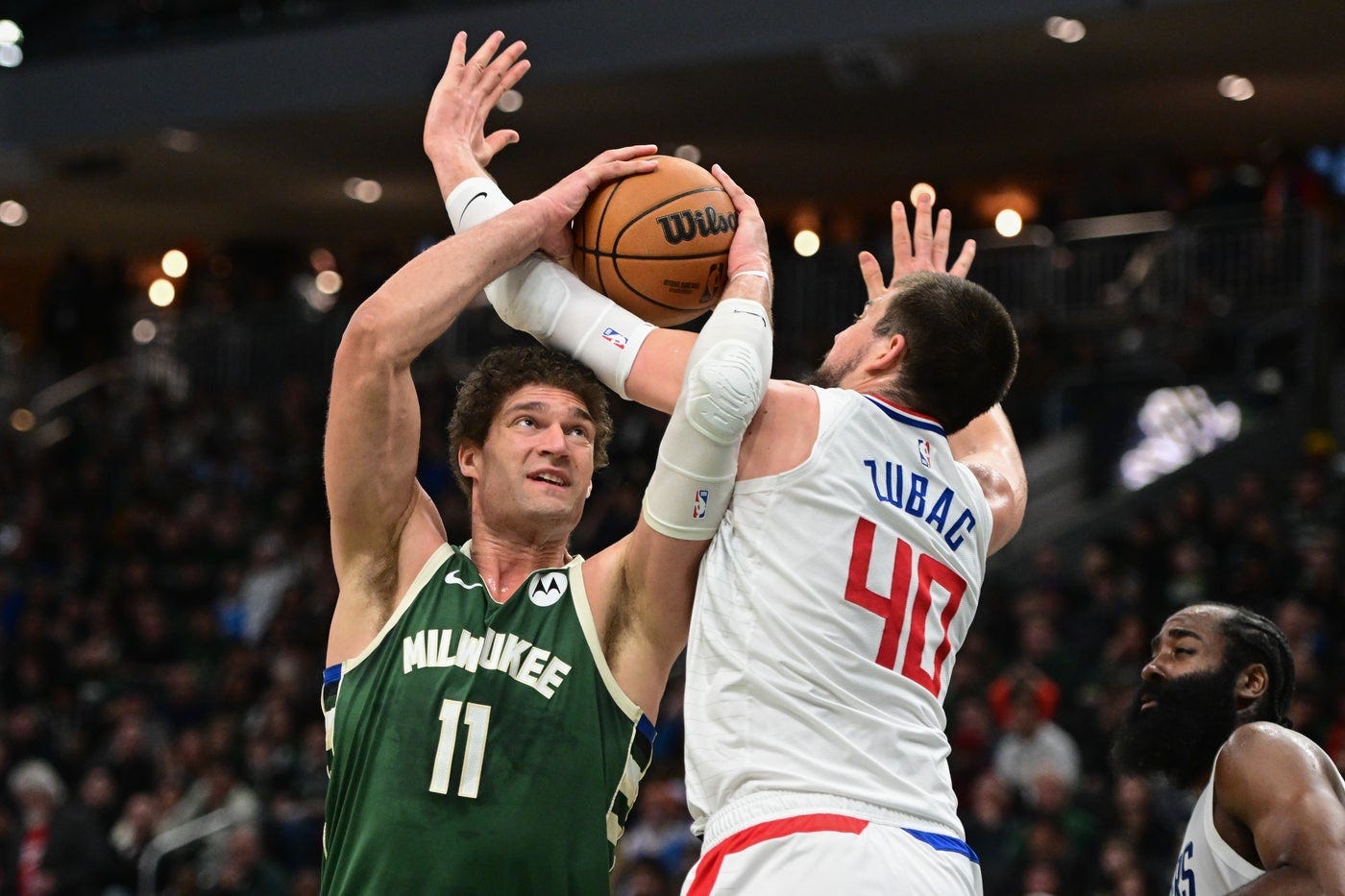
There’s been a lot of great promos throughout the history of the wrestling business, but there’s one that hovers above the rest when we’re discussing who stands at the mountaintop of delivering the pièce de résistance in the industry.
Of course, I’m talking about Dusty Rhodes’ iconic “Hard Times” promo from October 1985. It’s been 40 years and it still reigns supreme.
In it, there’s a 10-second sequence from Rhodes that still reverberates through the halls of greatness:
I admit, I don’t look like the athlete of the day is supposed to look. My belly’s just a lil’ big, my heinie’s just a little big, but brother, I am bad and they know I’m bad.
Rhodes was 40 years old when he gave that speech. A working class superhero for a people that hung on every word he said, drop of blood he spilled, and rush of adrenaline he gave them. It’s that speech which encapsulates so much of what made Rhodes great: he connected with everyone because he was everyone.
That one quote reminds me a lot of Brook Lopez, one of the new members of the LA Clippers. The team signed Lopez via part of the non-taxpayer mid-level exception, an amount of $8.75 million for this upcoming season and then a team option for 2026-27 at $9.19 million.
Lopez, 37, stands 7’1” and 282 pounds, if you go off of his Basketball Reference page. Lopez can lumber around the court, look a bit out of place, and seems like he’s ready for his legs to finally rest. In essence, he might not look like the (basketball) athlete of the day is supposed to look. But brother, he is bad and the rest of the league knows he’s bad.
The move reunites Brook Lopez with his protégé from their time together on the Los Angeles Lakers, starting center Ivica Zubac. (More on that later!)
Lopez could have had a starting job elsewhere, but instead he’s heading to the Clippers to fill a much-needed backup gig for a team that has sorely missed that impact since the departure of Isaiah Hartenstein in free agency several years ago.
That role is a massive one, and we’re here to look at the ways Lopez can help the Clippers, as well as what life has been like for him recently.
So, what does Brook Lopez bring to the Clippers? Let’s talk about it.
⨕ SUGAR, SPICE, AND EVERYTHING NICE!
Last season for the Milwaukee Bucks, Brook Lopez averaged 13.0 points, 5.0 rebounds, 1.8 assists, and 1.9 blocks in 31.8 minutes across 80 games. Lopez shot 50.9% from the field, 37.3% on 3s, and 82.6% from the free throw line.
Among the 27 players to log at least 2,500 minutes, Lopez was 5th in Effective Field Goal Percentage and 7th in True Shooting Percentage.
If you adjust it to only account for the 21 players who logged at least 2,500 minutes and attempted at least 300 3-pointers last season, Lopez ranked 3rd in eFG% and 5th in TS%. Considering he was a center, and he’s now 37 years old, that’s mighty, mighty impressive.
But I don’t want you to lose the forest for the trees here. The biggest takeaway is that a 7’1”, (at the time) 36-year-old center logged 2,546 minutes last season. Only 25 players finished with more minutes played than Lopez did. And none of them were Lopez’s age. The only other players over the age of 30 to even reach that total were James Harden (35) and DeMar DeRozan (35). So, just think of what category that puts Lopez into.
Oh, and if you’re into interesting little factoids:
Yeah! That’s right! Brook Lopez is in a trivia answer alongside Kareem Abdul-Jabbar. And both won a title with the Bucks! What are the odds?!?!?!
OK, OK. I’m sorry. I got a little carried away.
Lopez was a key contributor to the Milwaukee Bucks, leading them in minutes last season, and was an integral part of what they do on both ends of the floor.
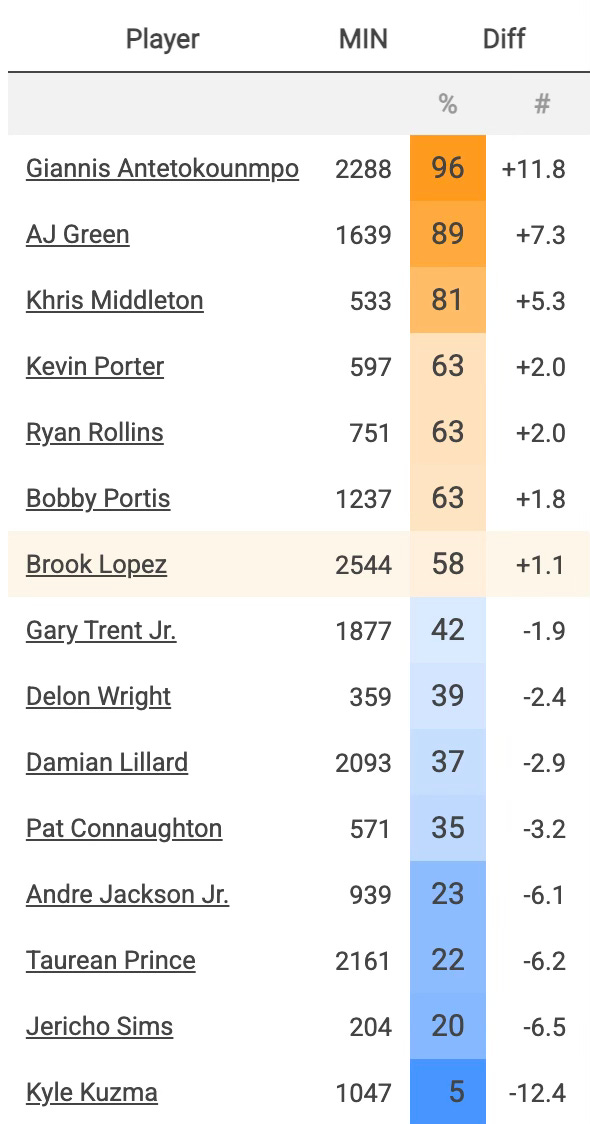
Among the eight players on the Milwaukee Bucks last season that logged at least 1,000 total minutes, Lopez was fourth in Net Rating differential, with a +1.1 margin, according to Cleaning The Glass. Is that a great mark? Not really. It’s better than league-average, obviously, but it’s nothing to write home about.
However, I do think there should be a healthy amount of context that’s provided in this.
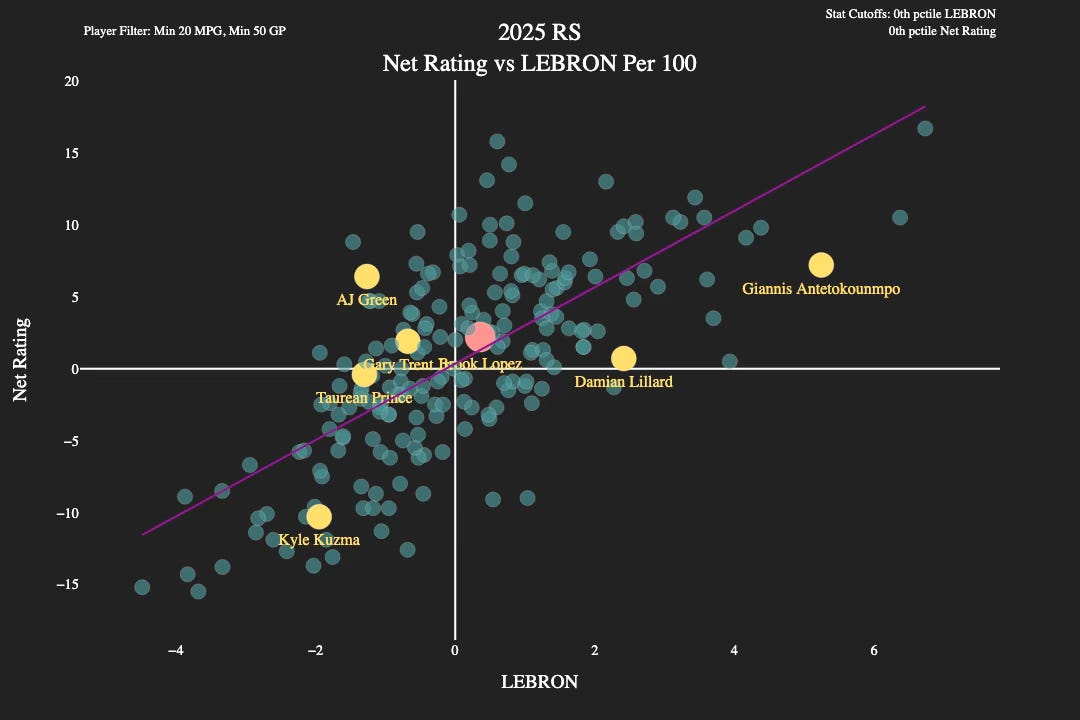
Lopez was one of just three players on the Bucks last season, amongst the qualified players, who finished with a positive Net Rating and a positive LEBRON (Luck-adjusted player Estimate using a Box prior Regularized ON-off). The Bucks outscored opponents by 2.5 points per 100 possessions with Lopez on the floor, per Cleaning The Glass. And the big man had a +0.44 rating in the LEBRON metric, courtesy of B-Ball Index.
In the 2,232 non-garbage time possessions that the trio of Lopez, Damian Lillard, and Giannis Antetokounmpo spent on the floor together in 2024-25, the Bucks posted a +5.2 Net Rating. It did go up to +6.2 when Lopez sat and Lillard and Antetokounmpo remained on the floor, but that was also over just a small 517 possession sample size.
(To show how wonky it was for Milwaukee last season, the Bucks posted a +9.0 Net Rating in the 913 possessions that Lopez and Antetokounmpo played without Lillard. And if you want a fun one, the Bucks had a +15.7 Net Rating in the 451 possessions that Lopez, Lillard, Antetokounmpo, and sweet-shooting A.J. Green played together. We must respect “Dairy Bird” out here.)
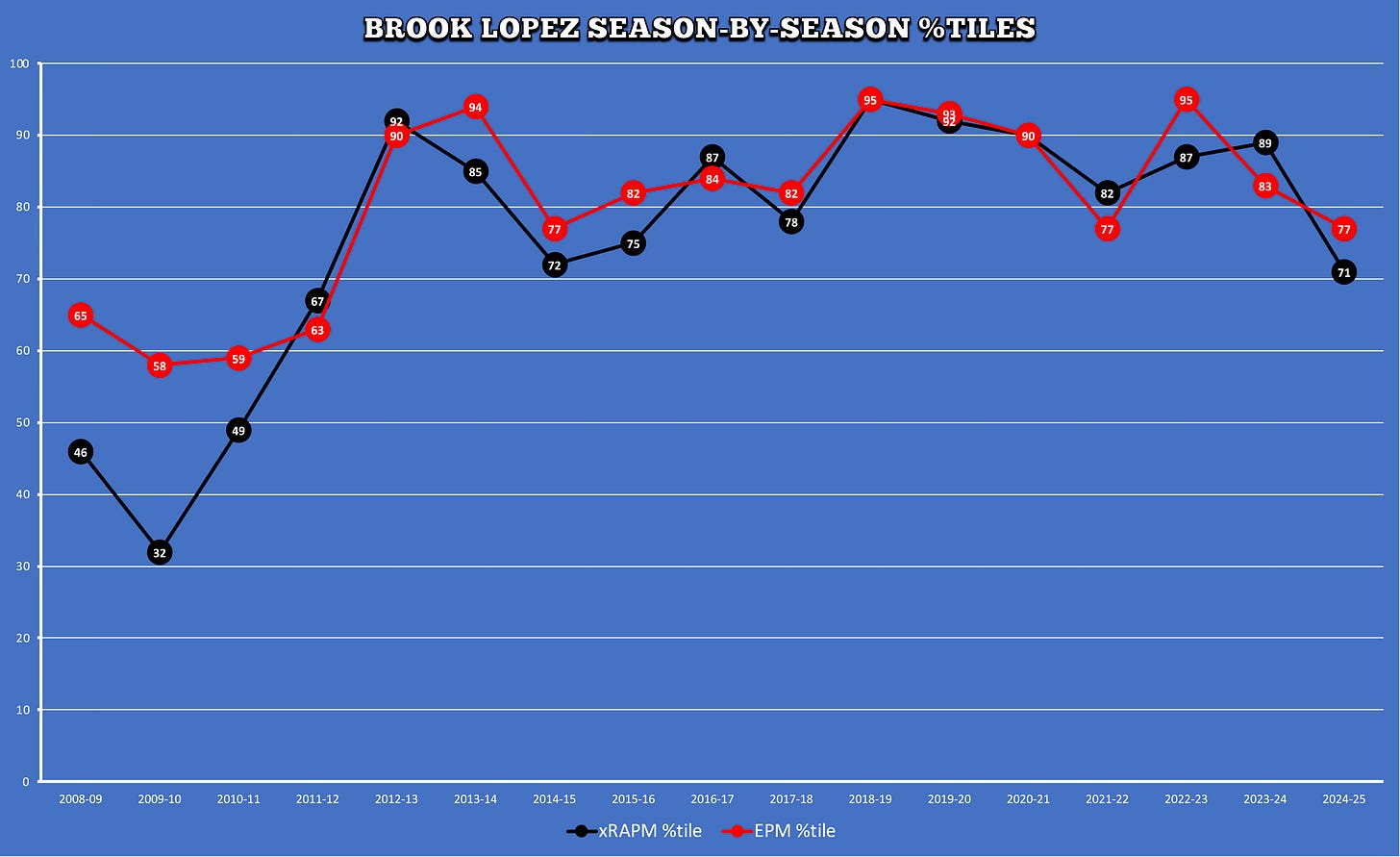
Over the course of Lopez’s career, at least over the last 13 seasons, the big man has graded out in the 70th percentile or higher in both Regularized Adjusted Plus Minus (xRAPM) and Estimated Plus-Minus (EPM).
In other words: Brook Lopez has been a positive impact player for well over a decade, and found a way to stabilize himself after a middling-ish first couple years in the league.
You don’t make it 17 years in the NBA—no, seriously, Brook Lopez has been in the NBA for SEVENTEEN years—if you’re a bad player, and the big man has been anything but “bad” during his time in the league, even if it started off a little rocky for him.
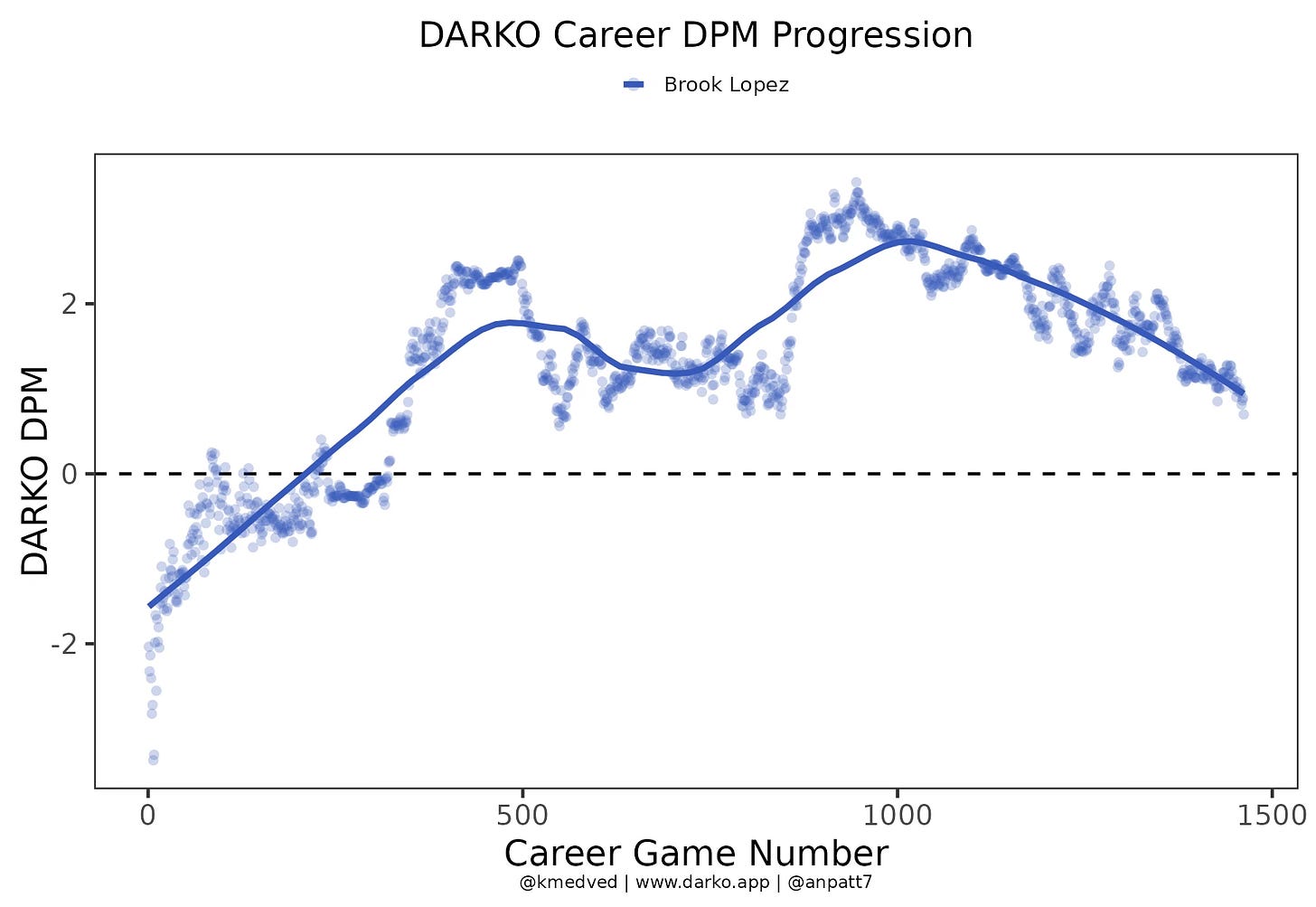
Last of the advanced data we’re looking at is Lopez’s Daily Adjusted and Regressed Kalman Optimized projections (DARKO) Daily Plus-Minus (DPM) career progression, which, while it has seen a steady decline over the last 500 games or so, still illustrates that Lopez makes a very healthy impact on the game despite his age, potential physical limitations, and everything in between.
This is part of what makes Lopez one hell of an intriguing fit on the LA Clippers. It’s also what makes him a bad, bad man instead of just bad, man.
We’ll get into more of what has led to some of the longevity in Lopez’s career in just a bit, but I wanted to touch on one more thing: you cannot underestimate size. It sounds simple, and yet we see it all the time.
The NBA has leaned back into playing, if not more traditional bigs, multiple bigs who supply a multitude of skills that gives them increased functionality around each other. We saw it with the Houston Rockets this past postseason, we saw it with the Oklahoma City Thunder all year when Isaiah Hartenstein and Chet Holmgren were healthy, and there was a bit of it with the Indiana Pacers, as well. Double-big lineups came back, and the revival of “hey, look at this big dude causing havoc” was very real.
With that said, these are the five most important questions surrounding Lopez’s upcoming season: (1) In what ways can he be used offensively?; (2) Is there any chance he can play alongside Ivica Zubac?; (3) How will the defense hold up with him out there?; (4) Can the Clippers get creative with Lopez on the floor?; (5) What can you draw from the past to look toward the future?
❶ CAN CLIPPERS WIN THE SPACE RACE?
At the risk of losing everyone in a deluge of graphs and charts and things like that, I present you to what Brook Lopez was like as an offensive player through his first eight seasons in the league:
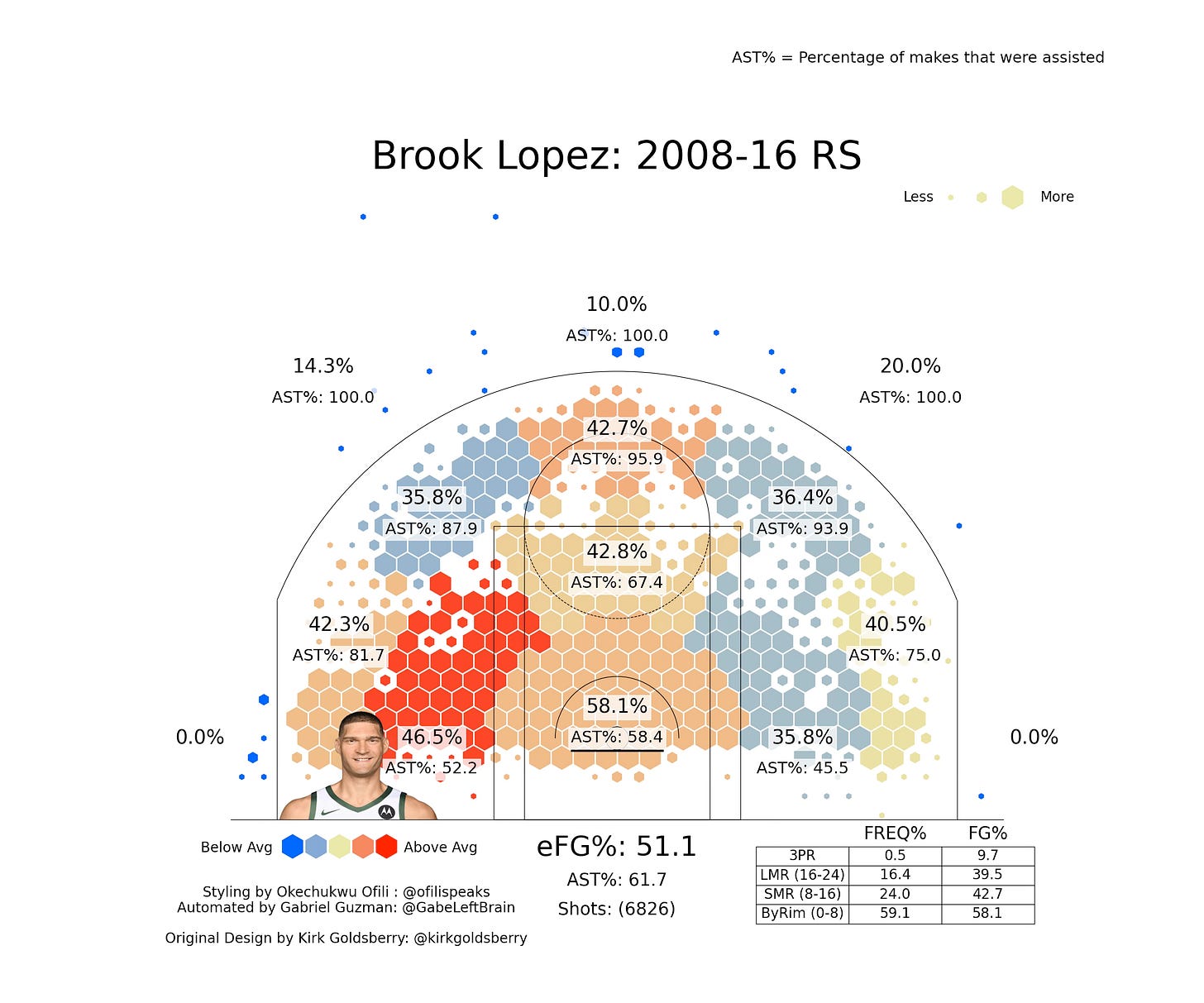
Look, there’s nothing truly wrong with it. We can say that. Lopez took 59% of his shots near the rim, making 58% of them. That’s not terrible. He was mostly a post-up player and had to create offense for himself, as evidenced by only 58.4% of his shots near the rim being assisted.
Lopez was a throwback big during a time when this was the norm. We all remember the awesome offensive seasons that players like Al Jefferson, Zach Randolph, and players of that ilk provided. This was the era in which Lopez lived, averaging 18.3 points and 7.4 rebounds on 51.1% shooting across those eight seasons. That’s not nothing. That’s a highly productive offensive player during his era.
During those eight years, Lopez’s Adjusted eFG% (eFG+) was 102, slightly above league average (100). His Adjusted TS% (TS+) was 104, also moderately above league average. But something changed after his eighth year in the league.
You see, Brook Lopez started … shooting … 3s???
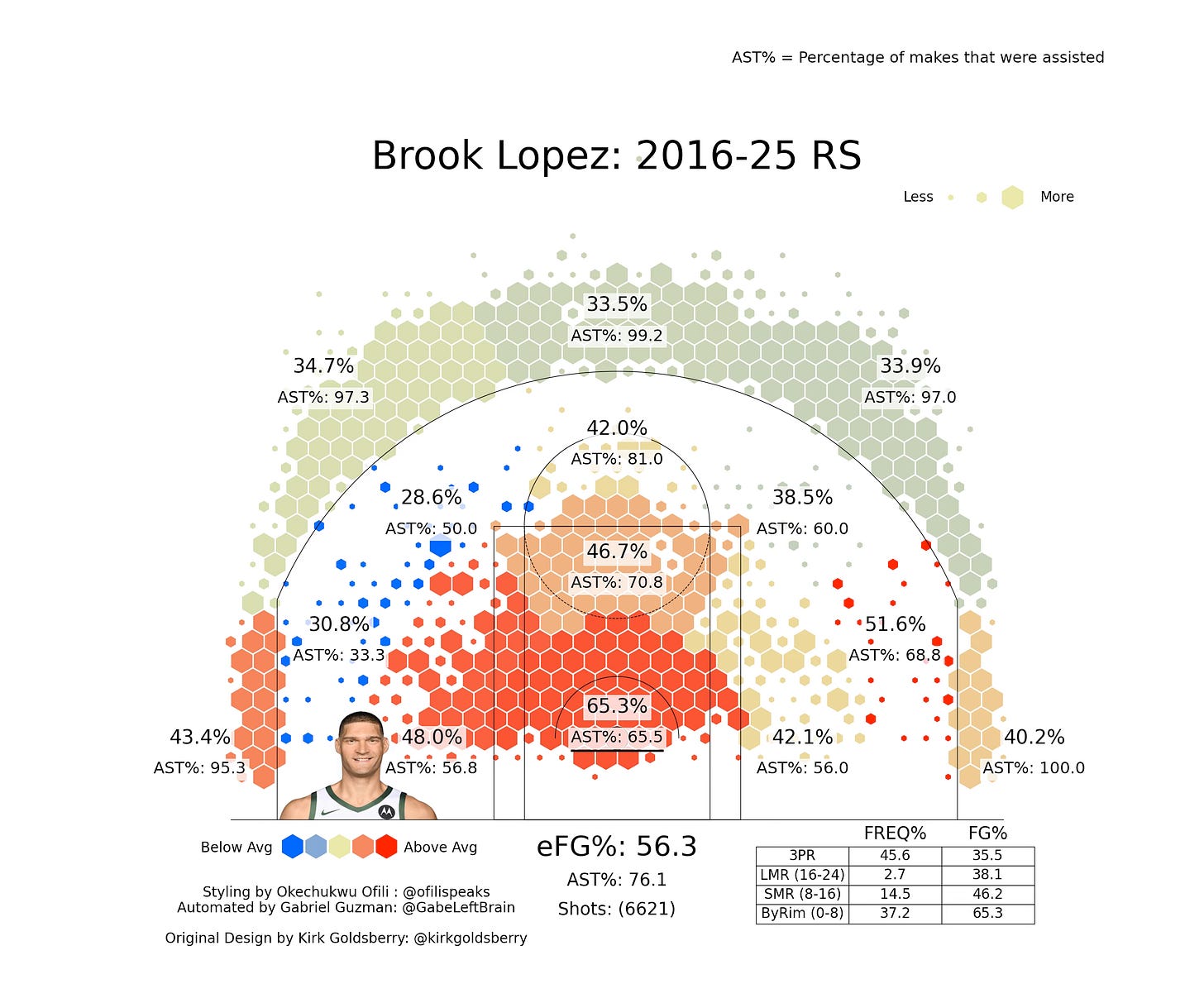
You’re looking at perhaps the biggest shooting chart change in modern times.
Brook Lopez, a big man who was known for posting up and mid-range shots, completely evolved his game to start taking 3s.
Lopez has averaged 13.9 points and 5.1 rebounds on 48.2% shooting over these last nine seasons, but he’s made 35.4% of his 3s, and therein lies the biggest boon to his efficiency levels. (And, if you notice in the chart above, Lopez has been assisted on 76% of his made baskets over the last nine seasons, showing a remarkable 14.4% rise in assisted baskets compared to his first eight years, meaning he isn’t having to feed himself. He’s let others cook for him.)
It’s what has allowed Lopez to stay in the NBA for as long as he has: he adapted and evolved to the changing league around him, which only illustrates and highlights the sheer intelligence of the man and his overall basketball ability.
Lopez, whose TS% was 56.4 through his first eight seasons, has seen it go to 59.4 in the nine seasons since. His TS+ moved from 104 to 105, but more importantly his eFG+ went from 102 to 106. That might not seem like much, but during a time where everyone is starting to become more efficient, not just players but offenses in general, a center who shoots 3s seeing their efficiency level increase even by a point or two relative to league average is something to behold.
Not everyone can be Nikola Jokic (112 eFG+ and 113 TS+ over the last nine seasons), but Brook Lopez has basically been Al Horford (106 eFG+ and 102 TS+) and Myles Turner (105 eFG+ and 106 TS+) over that same time period, at least from an efficiency standpoint.
This is what makes Lopez so damn intriguing!
He went from never doing something to now doing it a lot. And he’s doing it at a high, high level. There’s fascination in that.
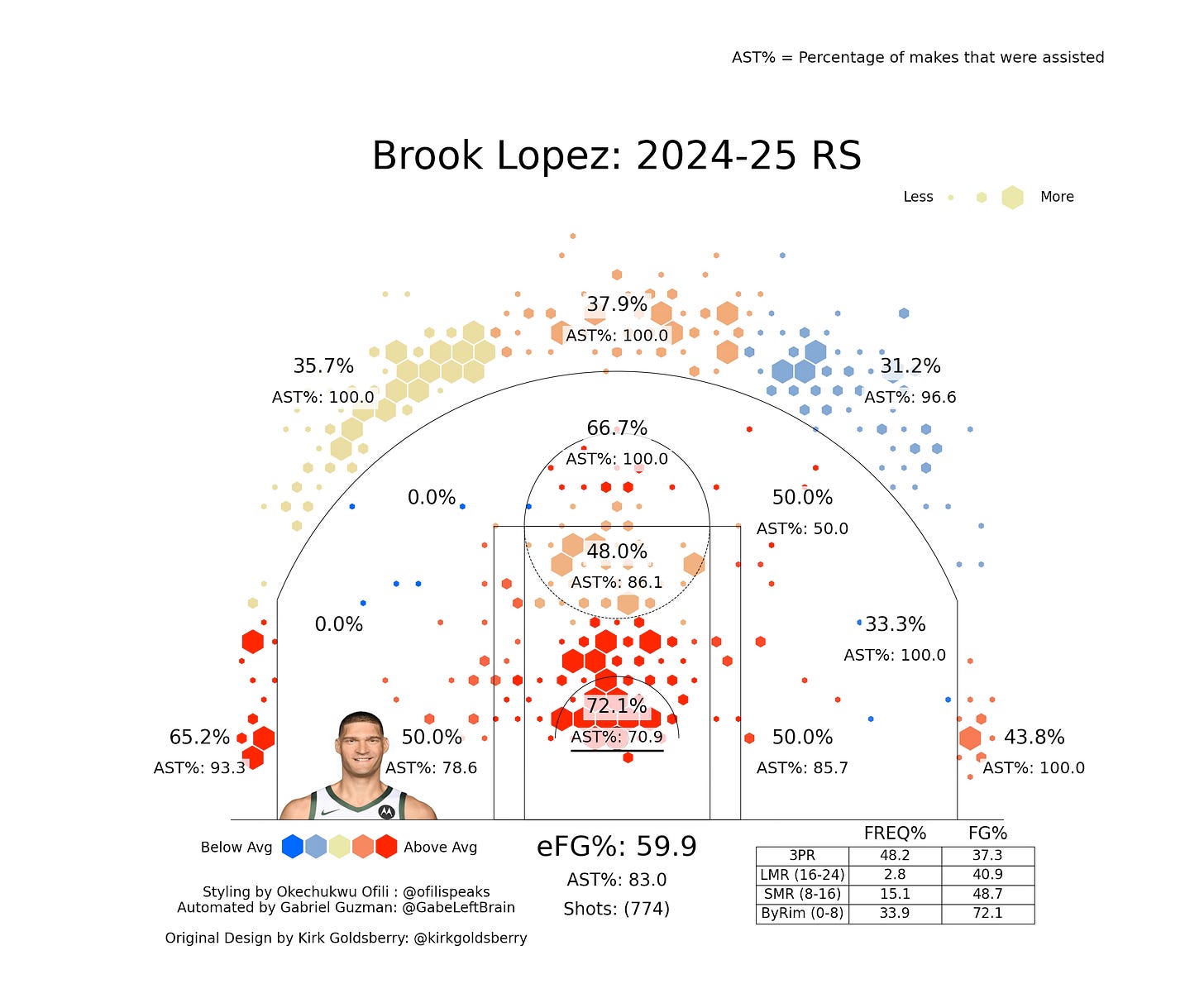
Last season, 48% of Lopez’s shots were 3s, and another 34% were around the rim. Roughly 82% of Lopez’s attempts came in those two areas, and he posted a combined 62.6 eFG% on those shots. Remember how we mentioned Myles Turner a minute ago? Turner posted a 59.5 eFG% on similar shots last season, and 84% of Turner’s total attempts came in those areas.
In other words: Brook Lopez, who will be making $16.6 million less than Myles Turner this upcoming season, offensively profiles much along the same path as Turner does. There wasn’t much difference in xRAPM (+0.3 for Lopez, +0.4 for Turner) nor EPM (+0.7 for both) last season. Age, of course, factors into the financial disparity, as does mobility and optionality.
But none of this talks about the biggest factor with Lopez’s arrival to the Clippers: the spacing will matter. And it will matter a whole hell of a lot to a team that needs to take more 3s and space the floor. Lopez provides that out the wazoo.

The Clippers, quite simply, just don’t take enough 3s or shots at the rim. A reason for that is because Kawhi Leonard loves to live in the mid-range, and they’ve had a lot of players who can do damage in the short mid-range area—i.e., floater range. Norman Powell’s done it, James Harden has as well, Ivica Zubac is one of the best in the league at it, and so on and so forth. It works.
But there does need to be some added variation offensively, and Lopez can supply some of that with his insane range, shooting touch, and ability to be a force down low when given the ball.
Milwaukee has been better than league average in At Rim + 3-Point Frequency Rate in six of the seven seasons Lopez spent there, and they were within the top eight in four of them. Now, you can’t expect the Clippers to do that. That’d be a tad nonsensical of an ask. But they haven’t even been a league-average team in that regard since 2017-18, when they finished 5th. Perhaps Lopez can fix some of that?
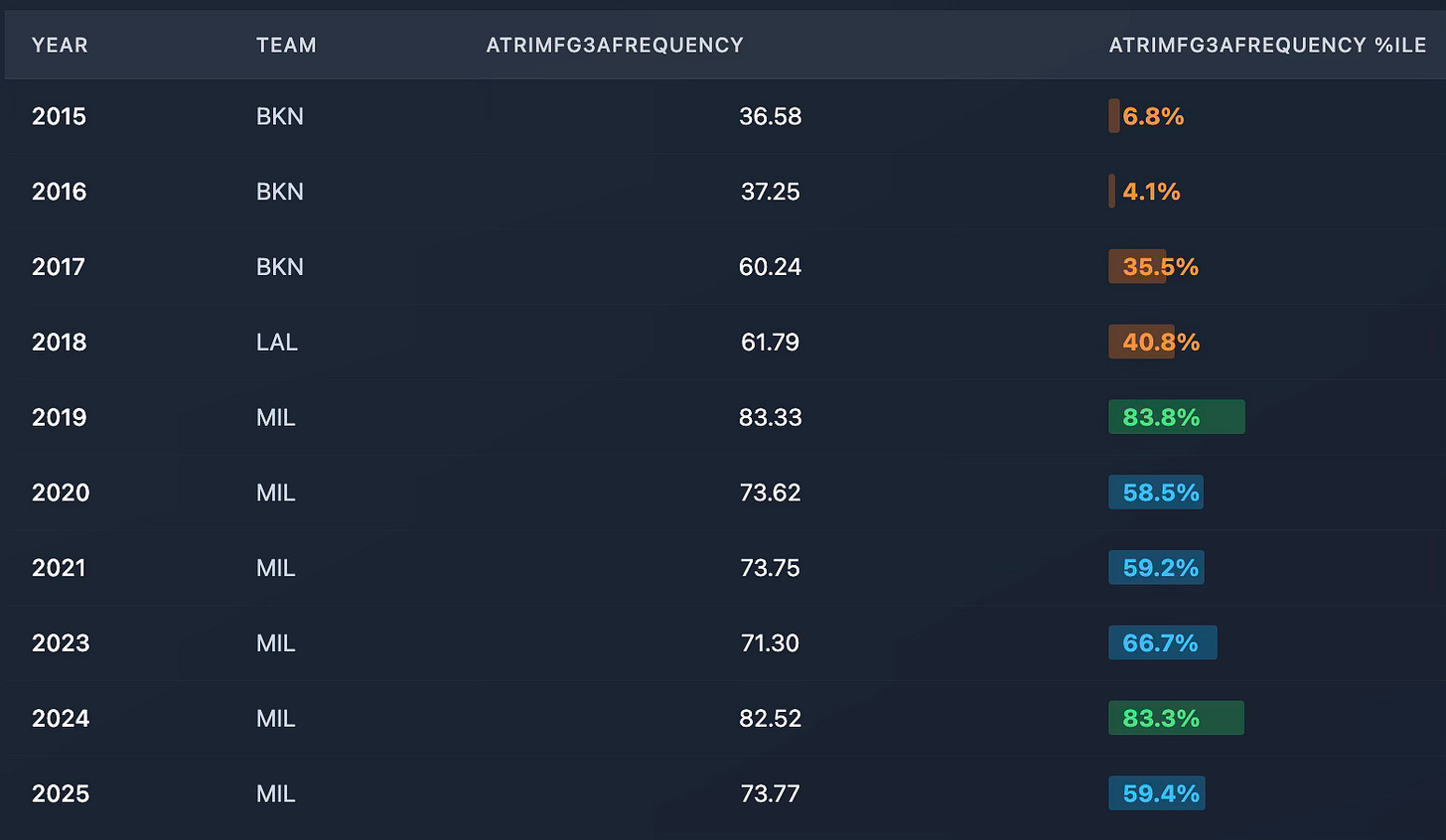
Lopez has generally fared pretty well in recent years, at least individually, when it comes to his own percentile ranks in At Rim + 3-Point Frequency Rate. The center has posted good marks since arriving in Milwaukee, routinely finishing with at least 70% of his shots coming from those areas, and it’s ranked him pretty highly percentile-wise in a few of the seasons.
It’s a nice window into some of the ways the Clippers can take advantage of having the big man on the floor, and another way they can do that is just by sheer distance. If that doesn’t make sense, it will.
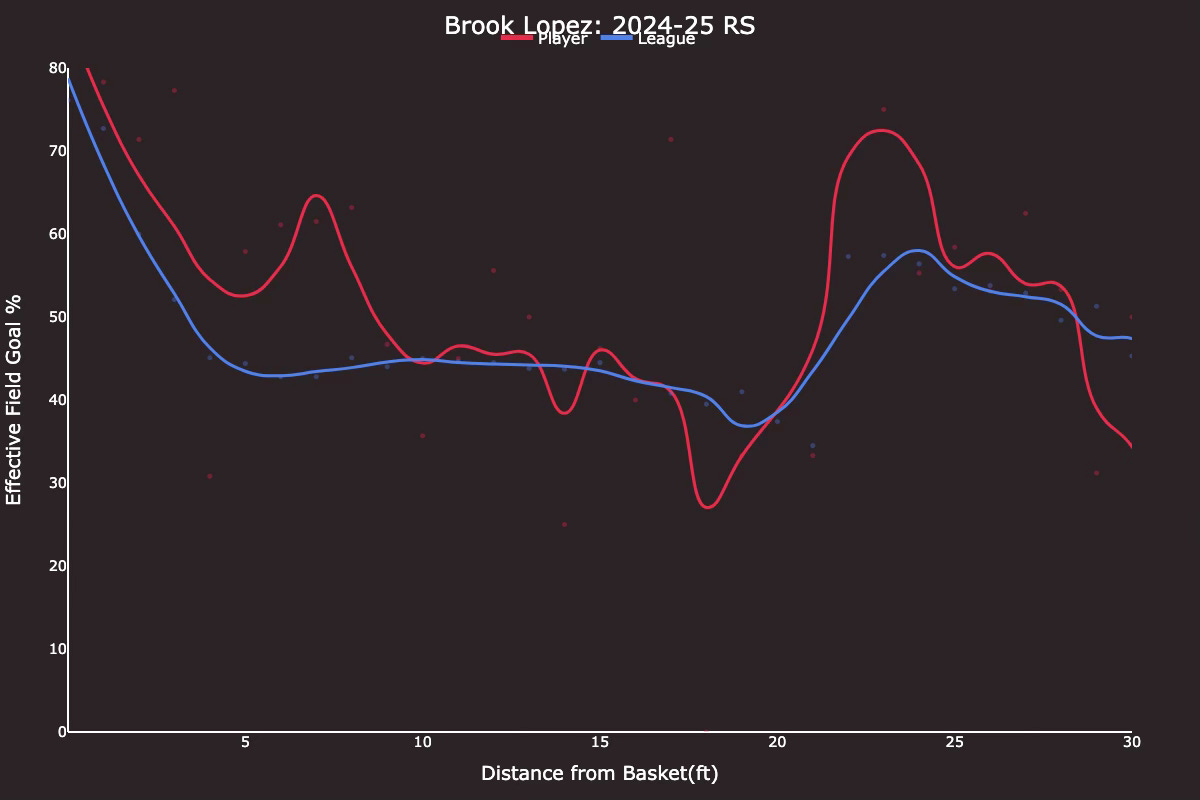
You see that little red blip between the 20- and 25-foot range that just suddenly jets upward? Yeah, that’s not normal! That’s a player who is wildly outperforming the league average on 3s, and it gives some insight into just how Lopez can aid the Clippers.
Not all spacing is the made the same. Some players space the floor with their toes on the line, some players space it more in the corners. And then there’s Brook Robert Lopez, aka Splash Mountain.
Whether he’s spacing on the wing …
Or spacing as a trailer in secondary transition sequences …
Or as a pick-and-pop threat at the top of the arc when a teammate is able to draw two to the ball …
These are the things Lopez can bring to the Clippers on the offensive end. It’s a 7’1” version of what the Clippers wanted out of Eric Gordon when he was on the team a few years ago.
Or, in the words of Kawhi Leonard in 2023 in regards to Gordon and the spacing the guard provided:
Well, I mean, if he’s two, three feet behind the 3-point line, that makes the defender, you know, wanna be that much closer to him. So, when we are penetrating gaps, you definitely gonna have space there and, you know, that’s what’s helping. When we’re trying to attack the paint, that guy is not one or two feet closer to that line where he can either make you pull it out or get a hand on the ball and try to steal it. So, yeah. I think that’s just helping us get to the paint and when they do help, he’s just that much further for them to close out. It’s a good look for him.
Among 7-footers, only Victor Wembanyama, Kristaps Porzingis, and Karl-Anthony Towns made more shots from 30+ feet than Lopez did last season. Since Lopez morphed into a 3-point weapon, only Porzingis has made more shots from 30+ feet among 7-footers than Lopez has. (This is where it has to be mentioned that Lopez is part of the “small group of unicorns” in the league who both protect the rim and shoot 3s.)
Spacing doesn’t just benefit the player shooting; it benefits everyone around that player.
With Lopez on the floor, there should be more gaps, as Leonard mentioned, for ball-handlers to get into, and thus more space to operate with once they get by the initial line of defense, which could lead to greater efficiency for the offense as a result since defenses could be caught in rotation much more often.
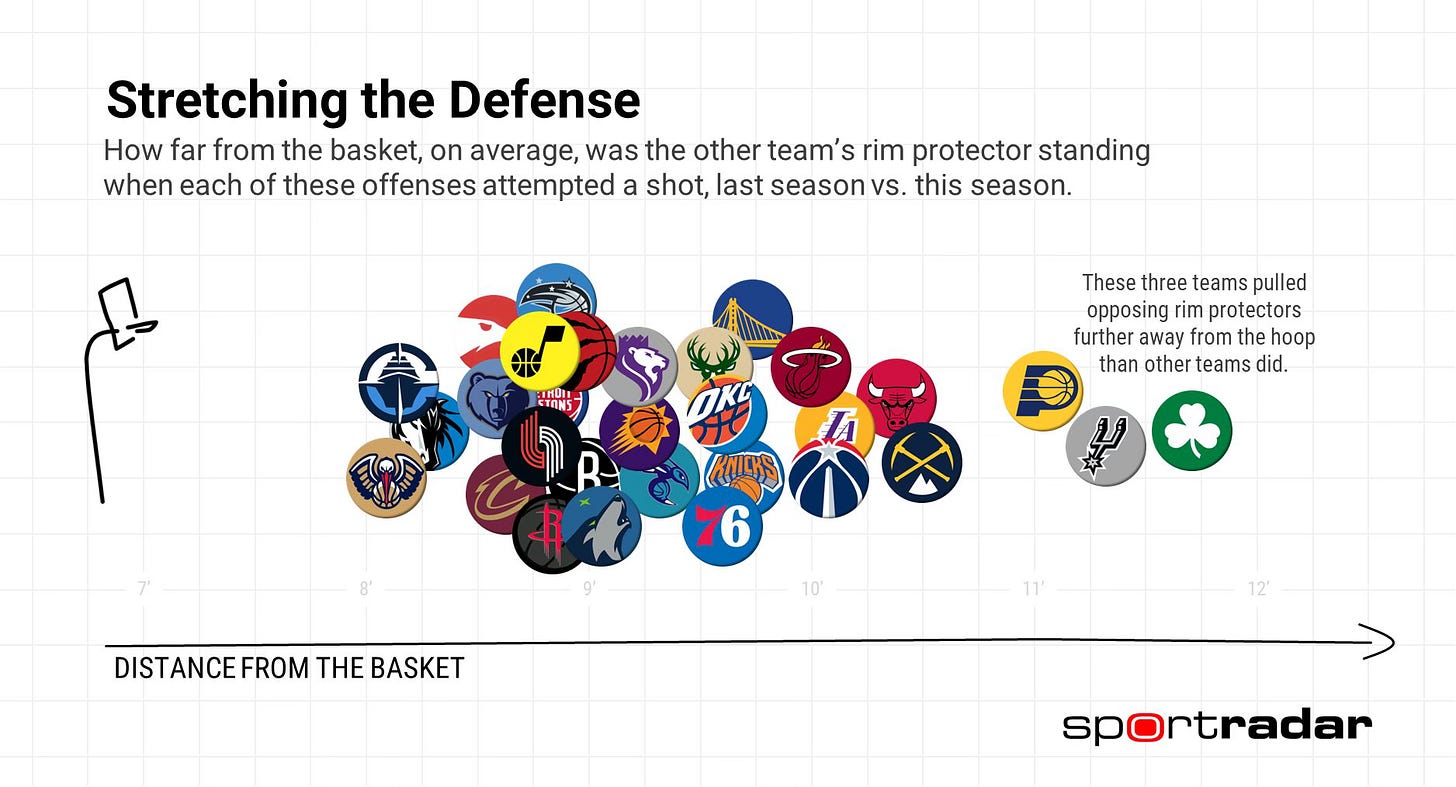
Only the New Orleans Pelicans saw an opposing team’s rim protector stand closer to defend the rim, on average, than the LA Clippers did last season.
I know we talk about spacing as a contextual thing, but this is a real data point we can look at and see just how much having someone like Brook Lopez, who was on a Milwaukee team that hovered around the Top 10 in this metric as far as furthest distance from the basket, could materially matter.
You know how it was mentioned that 48% of Lopez’s shots last season were 3s? He was one of 36 players to log 2,000 minutes and see that happen. He was 4th in eFG% among those players. The only centers on this list besides Lopez were Myles Turner (who we’ve talked about ad nauseam) and Naz Reid, who secured a five-year, $125 million deal this summer from Minnesota. Lopez destroyed both in efficiency. (For comparison’s sake: 75.6% of Reid’s baskets this past year were assisted; it was 90% for Turner. Reminder: Lopez was at 83%.)
Lopez took 358 catch-and-shoot 3s this past season, the 16th-most in the league. Both Lopez and Naz Reid, who attempted 375, made 37% of them. Myles Turner made 40% on 356 attempts. It made Lopez and Turner two of the four players this past season taller than 6’10” to attempt at least 300 catch-and-shoot 3s and feature in 100 post-ups. Say it with me: versatility! (The others were Nikola Vucevic and Jaren Jackson Jr.)
The Stanford alum averaged 1.20 points per possession as a pick-and-roll roll man, ranking 11th out of the 33 players to be logged with 100 such possessions. Those possessions made up 24.2% of Lopez’s play-type frequency.
Lopez registered 1.52 points per possession on putback opportunities, which led the NBA out of the 76 players who logged at least 50 such possessions this past season. The center also finished in the 95th percentile as a play finisher, posting 1.27 points per possession. (Getting the picture of what he does?)
This is all a very long-winded section and way to say the simplest thing: Brook Lopez is an extremely good offensive player whose arrival benefits the Clippers in three areas they could improve in: (1) 3-point volume and efficiency; (2) productivity around the rim, especially on putbacks where the Clippers ranked 19th last season despite how often they went for it by sending two to the glass; and (3) the spacing provides benefits to everyone else he’s on the floor with, making life easier for all parties involved.
❷ TWIN TOWERS OR FLEETING IDEA?
The most interesting question surrounding the acquisition of Brook Lopez is invariably, can he play alongside Ivica Zubac?
Now, I know what you’re thinking, because it’s the same thought I had: Of course not!
But that hinders actual discourse and the legitimate ponderance of thought. So, let’s talk about it. Can they coexist?
Offensively, it seems like yes. After all, Zubac is an incredible downhill roll threat who can play in both the short roll as a passer/playmaker and as a finisher in both the floater range and at the rim, especially with James Harden orchestrating the offensive charge.
There could be a world where Zubac is operating in a middle pick-and-roll with Harden, and Lopez is parked on a wing, spacing as he does. Or a world where Zubac is parked in the dunker spot awaiting the results of a Harden-Lopez pick-and-pop. Or a world where Lopez—or Zubac also—is able to post up against a smaller defender who gets mismatched onto him. But is that world the one we’re living in? We could find out.
Whatever issues this pairing could very well have likely won’t come about on the offensive end, but rather on defense as one of the two centers is going to have to defend on the perimeter. The likely candidate would be Zubac, who has gotten better away from the rim in recent years. With Lopez patrolling along the back line, maybe the Clippers can take more chances, especially if they opt to play a zone defense with those two at the back, or one up top and the other back.
Either way, there could be options aplenty.
Yet, we never quite saw Brook Lopez operate alongside another center in Milwaukee, and likewise for Ivica Zubac in Los Angeles. The only comparable dataset for Lopez would be with Giannis Antetokounmpo, but Zubac isn’t the offensive force Antetokounmpo is and he lacks the defensive dexterity on the perimeter that the two-time MVP possesses, so clearly there’s something amiss there.
In the 13,669 minutes that Lopez was on the floor during his Milwaukee career, only 155 of those—or a hilariously low 1.1%—were spent alongside a player you could even remotely characterize as someone who is comparable to Ivica Zubac’s skillset: a rim-running big man with limited spacing element.
Those 155 minutes were divvied up as follows: Thanasis Antetokounmpo (139), Mamadi Diakite (9), John Henson (3), Robin Lopez (3), and, if you can believe it, Pau Gasol (1). The Bucks were outscored by 13 points in that time. Is that something, nothing, or everything? Considering only 41 of those 155 minutes have come within the last four (4) seasons, it probably tells us nothing. (All of those were with Thanasis Antetokounmpo, with Milwaukee going -22 in those 41 minutes.)
But herein lies the rub, as the saying goes: what about Ivica Zubac with a stretch big alongside him?
In Ivica Zubac’s 11,899 minutes during his six-and-a-half seasons with the Clippers, the center has played 682 minutes—or 5.7% of his total time—alongside a player that could theoretically fit Brook Lopez’s mold: a stretch big who can play the five and maybe sometimes possibly the four.
You ready for the breakdown on this one? It’s a doozy.
431 of those 682 minutes were spent alongside Patrick Patterson, who might be the biggest question mark in this since you could mostly just classify him as a power forward, but Patterson was the backup center for the Clippers in the 2020-21 season when he and Zubac played 142 of those 431 minutes. It’s not nothing! The remaining players were as follows: JaMychal Green (155), Serge Ibaka (66), Mfiondu Kabengele (27), and Isaiah Hartenstein (3).
I took some liberties including Hartenstein, since he and Zubac mostly played in late game situations when the Clippers needed rebounds, and Kabengele, who didn’t really play much at all and didn’t show the necessary skills to hang in the league. But, their archetypes do fit in the Lopez mold … if you squint.
The Clippers were outscored by 60 points in those 682 total minutes.
Now that you’re like, ‘Oh man, this is all bad, forget the idea of the two together’, let me bring you back to life a little bit.
The Serge Ibaka stint is the most intriguing one. Yes, it’s only 66 minutes. Yes, that’s nothing. Yes, numbers in that small of a sample size can tell you quite literally anything you want them to. But take a walk with me for a minute.
Of those 66 minutes together, 31 of them were spent alongside Paul George. The Clippers actually won those minutes. By 9.
The lineup of George, Ibaka, Zubac, Marcus Morris Sr., and Reggie Jackson played a grand total of 28 minutes together, outscoring opponents by 10 points overall across two games. They played 18:22 together against the Los Angeles Lakers on Dec. 3, 2021, and then another 9:24 the very next night against the Sacramento Kings. The Clippers won the first game, lost the second. But they were +9 against the Lakers and +1 against the Kings.
Maybe, just absurdly enough, there’s a pathway to Lopez and Zubac working together if they can find some semblance of cohesion in a lineup that has to surely feature the likes of James Harden, Kawhi Leonard, and maybe someone like John Collins alongside them? It’s nutty, I admit.
But what is basketball if you can’t get downright crazy sometimes?
❸ DEFEND THE RIM AT ALL COSTS
I actually liked showing you all the notes I jotted down during my film work on the Bradley Beal article, so I figured I’d continue that and give it to you for my Brook Lopez piece.
So, without further ado, here that is:
Elite rim protector but can get taken to task on the perimeter on switches. Gets into a good stance on the perimeter but lacks the necessary foot speed (as you’d expect with size/age/wear) to consistently keep up. Can get sized up in drop and get caught retreating which leads to stepback 3s. Elite guards will hunt him, but fact he wants to retreat to basket helps him unless guard is big time 3pt shooter. Elite handlers can shake him with hesitation dribbles and half-spins. Does good job of contesting without fouling. Forces drivers into tough looks. If he’s going to play drop, help rebounding must be a thing from others. In drop, guard defenders need to hustle over screen and apply back pressure or else it leaves him on an island. Good job riding players with forearm on hip. Incredible recovery ability to block lob dunks. Tremendous weakside help diagnosis. Spins off back screens to rotate back into play against drives. Expertly maintains contact with assignment to allow extra time in paint. Skilled 2.9’er. Hustles hard back in transition defense to contest at rim. Ambidextrous shot contester—34 blocks with left hand, 83 blocks with right hand (blocks I could find video of). Contests right-hand drives with left hand, keeps right forearm on hip of driver to push into contest, doesn’t jump unless sure shot is going up. Contests left-hand drives with right hand, left forearm on hip, etc. Rarely contests across body.
It’s … a lot. I know. But! In my defense, there’s a reason for all of that.
We’re not going to show you video of each and every point in these notes, but I do want to touch on a few things as we go through this. Might as well start with the charts and graphs first, just to give you an idea, and then work our way into the video. (I’m sorry for all of this!)
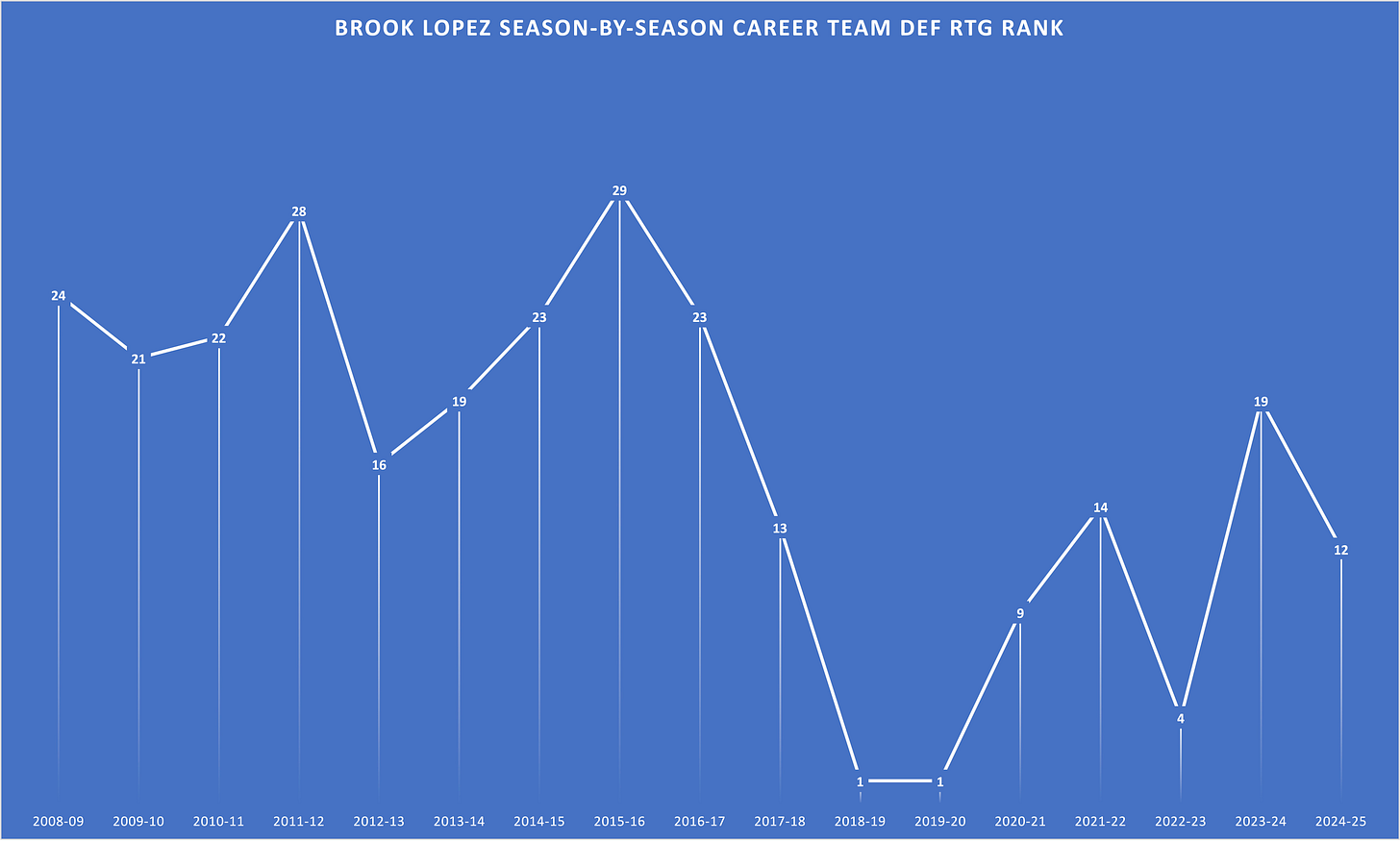
OK, just like with the Bradley Beal stuff, the lower you see a number, the better it is since this is a team’s rank within the 30-team structure of the NBA.
Since you are looking at this, you’ve probably noticed that it took until 2017-18, or, rather, Brook Lopez’s 10th season in the league for him to be on a team that finished in the top-half in Defensive Rating, ranking wise. Then Lopez went to Milwaukee, finished 1st in back-to-back years, and has since, basically, been on a good defensive squad outside of a tough 2023-24 season.
If you’re wondering whether or not this can be tied directly to anything related to Lopez himself, well, just have a look:
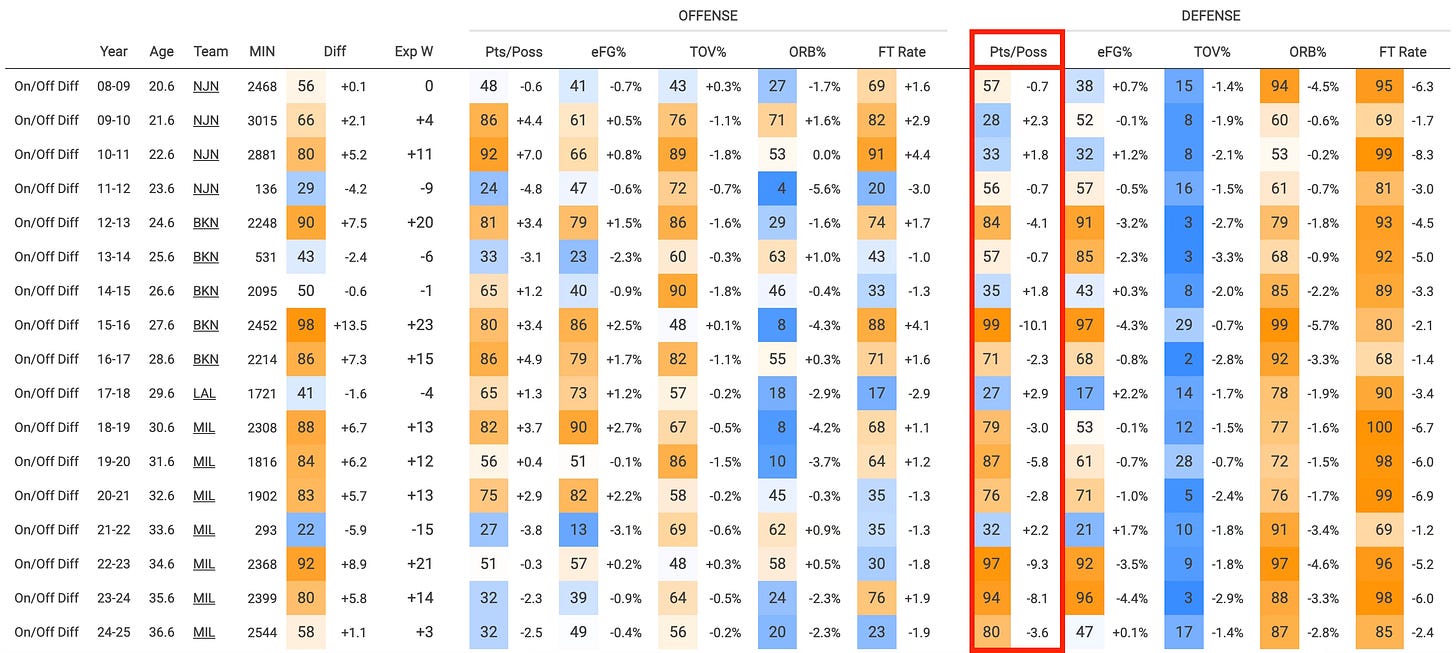
There’s only been two seasons out of the last 10 where Lopez’s teams were better defensively without him—the 2017-18 Lakers and the 2021-22 Bucks. But, even with that said, Lopez played only ~300 minutes with Milwaukee that year due to a back injury.
In general, if Lopez is on the floor, your team is going to be a quality defensive squad. It’s that simple.
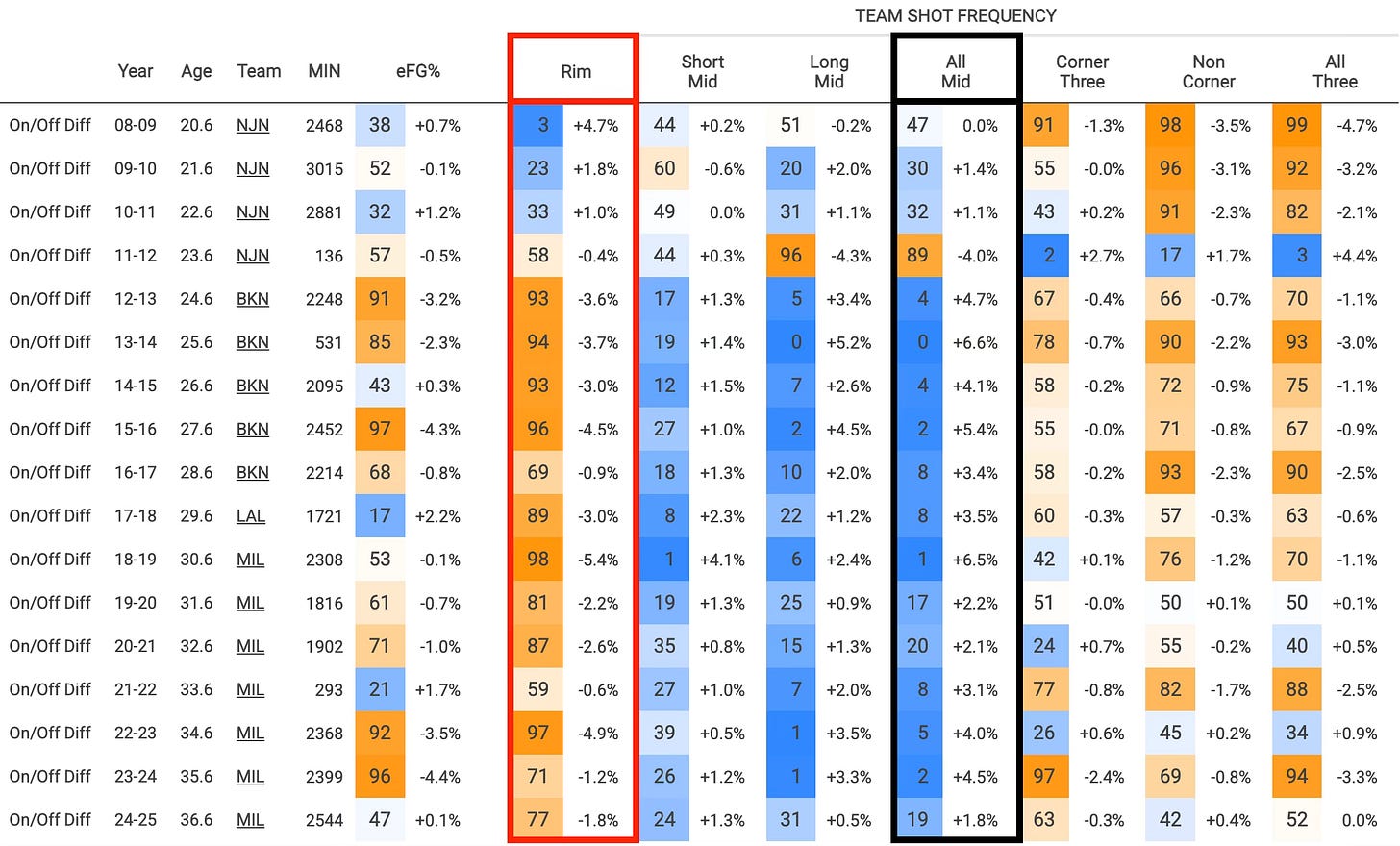
Even when adjusting for the types of shots that opponents are taking with and without Lopez on the floor, you’re seeing a positive marker for the big man in that, with him out there, opponents are taking far fewer shots at the rim than when he’s on the bench or missing entirely. Because of this, it’s pushing teams into more mid-range shots, or an area of the floor that is far less efficient than shots at the rim have proven to be.
It stands to reason that simply having a 7’1” behemoth standing near the rim is enough to deter even the most confident of players from challenging him anywhere near the level as if he wasn’t there in the first place.
Limiting shots in highly efficient areas is a good thing. It seems obvious!
Because of Lopez’s propensity to be deployed in drop coverage, he’s a natural rim protector, and that drop coverage also helps limit 3-point attempts for opponents if the guard defender is able to get over the top of screens at a positive rate and deter those types of attempts. It all works together in harmony, and Lopez is the orchestrator of some beautiful music when he’s out there.
If there is a defensive area of concern for Lopez, beyond the stuff we’re about to watch and get into even more in-depth, it’s the rebounding.
For his career, Brook Lopez has rebounded just 15% of all available defensive rebounds when he’s been on the floor. Among all players who have logged at least 33,000 career minutes, of which there are 113 (109 with data), Lopez ranks 55th in Defensive Rebound Rate (DRB%). When adjusting for just players who saw time at center, he’s dead last among the 15 players there’s data for.
In short: Brook Lopez is the worst defensive rebounding center in the history of the NBA amongst players who saw 33,000 career minutes. Or who were 7-feet tall. Or who played 30,000 minutes. Or 25,000 minutes. And nearly for 20,000 minutes, but his twin brother, Robin, edged him out. Or 15,000 minutes, where he tied with Andrea Bargnani for second-lowest. (This could go on-and-on.)
But does this really matter? Sure, he’s bad at rebounding. The numbers literally say it. Is it hurting his teams, though?
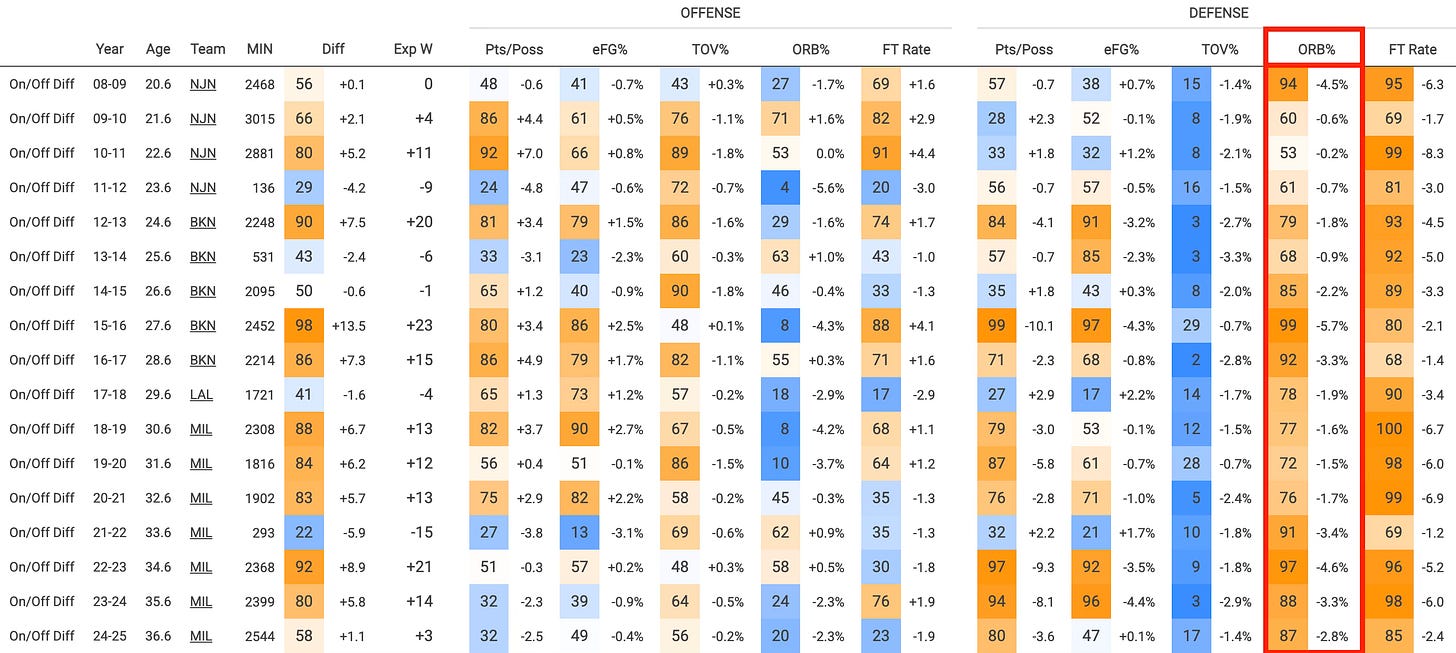
The answer, almost comically, is no!
Brook Lopez being one of the worst rebounding 7-footers in the history of basketball is not hurting his team. In fact, his teams are better on the defensive glass with him than when they play without him. It’s nuts.
It doesn’t make sense, does it? How can it be? This guy doesn’t rebound the ball but his teams do. And that’s how we get to one of the greatest questions in sports: does it matter who gets the rebound as long as someone on the team gets it?
We have a 17 year track record of Brook Lopez teams being not just better on the defensive glass with him out there, but tremendously better despite him not being the guy who is hauling them in.
Lopez has never averaged even 6.0 defensive rebounds per game in any season during his career. Not once. Not even by chance, happenstance, or whatever other verbiage you want to throw out there. This is a player, mind you, who just set the record for the lowest DRB% in any season by a 7-footer (minimum 2,500 minutes played). For good measure, he broke his own record.
(There’s a fascinating name on that list, by the way: Kareem Abdul-Jabbar makes five appearances in the Top—err, bottom?—30, all happening between his Age 34 and Age 38 seasons.)
So how can that be for Lopez to be so poor at defensive rebounding but his teams to be so good at it? I give you the greatest skill of all-time: boxing out.
Among players to play at least 1,500 minutes last season, Lopez was tied for 5th in defensive box outs per minute. He posted an identical rate (0.05) the year before. And the year before that. In 2020-21, he was at 0.09, which ranked tied for 2nd. He was tied for 4th in 2019-20, 3rd in 2018-19, and 2nd in 2017-18.
Can these stats be wonky? Of course they can. But one thing seems pretty clear despite all of it: Brook Lopez is arguably one of the greatest box-out bigs we’ve seen, even if he’s not securing the rebounds himself, and that’s a skill that matters for a team like the Clippers that finished last season ranked as the top defensive rebounding team in the league and would certainly like to keep their place in the hierarchy.
Now that we’ve nerded out for a bit, we can look at the defensive tape to see some of the things he has going on down on that end of the floor. Roll it!
ELITE GUARDS CAN FIND SUCCESS
This shouldn’t be too shocking to hear considering his age, size, and mobility limitations at this point of his career, but Brook Lopez can have issues at times defending some of the elite guards and ball-handlers in the game. Does this mean he isn’t a good defender? No. That’s where the context is needed.
Lopez, because of his 7’1” frame and drop tendencies, likes to back up on ball screens in order to defend the paint. It’s part of Milwaukee’s scheme, as well, and it’s why there can be some miscommunication at times in pick-and-roll settings that can, as we see a couple times in this clip, lead to wide open 3s for guards when the on-ball defender gets washed out of the play or Lopez is hanging too far back in drop.
Then there’s the big man lacking the foot speed on the perimeter to keep up with guards who can throw hesitations, hang dribbles, half spins, or even a hard jab step at him. Lopez can also get beat on straight-line speed drives by the top-tier types of players, as well. It’s OK, though. It’s not the end of the world, and you’re willing to live with some of these sequences because of quite literally everything else he can provide on the defensive end.
THE HUSTLE DON’T STOP
One of the fun areas of Lopez’s defensive game is that he’s really, really good at hustling back defensively in transition, and there are a lot more instances of him being fantastic at it than I have shown above. This is merely just a brief glimpse into his all-hustle mentality.
Lopez doesn’t take anything for granted, and the fact a 7’1” center is willing to compete like this in transition, even to the point where he’s sprinting back to meet shot attempts by eager opponents, says a lot about his mental makeup and determination. He’s a willing combatant, not a conscientious objector.
RIM DETERRENCE
Obviously an area of Lopez’s defense that’s going to get most of the acclaim is his raw rim protection, or even just his rim deterrence as he keeps opponents from attempting as many high-value shots down low as they’d like.
Brook Lopez was third in the NBA this past season in shots defended per game, and even that doesn’t speak to his impact nearly enough.
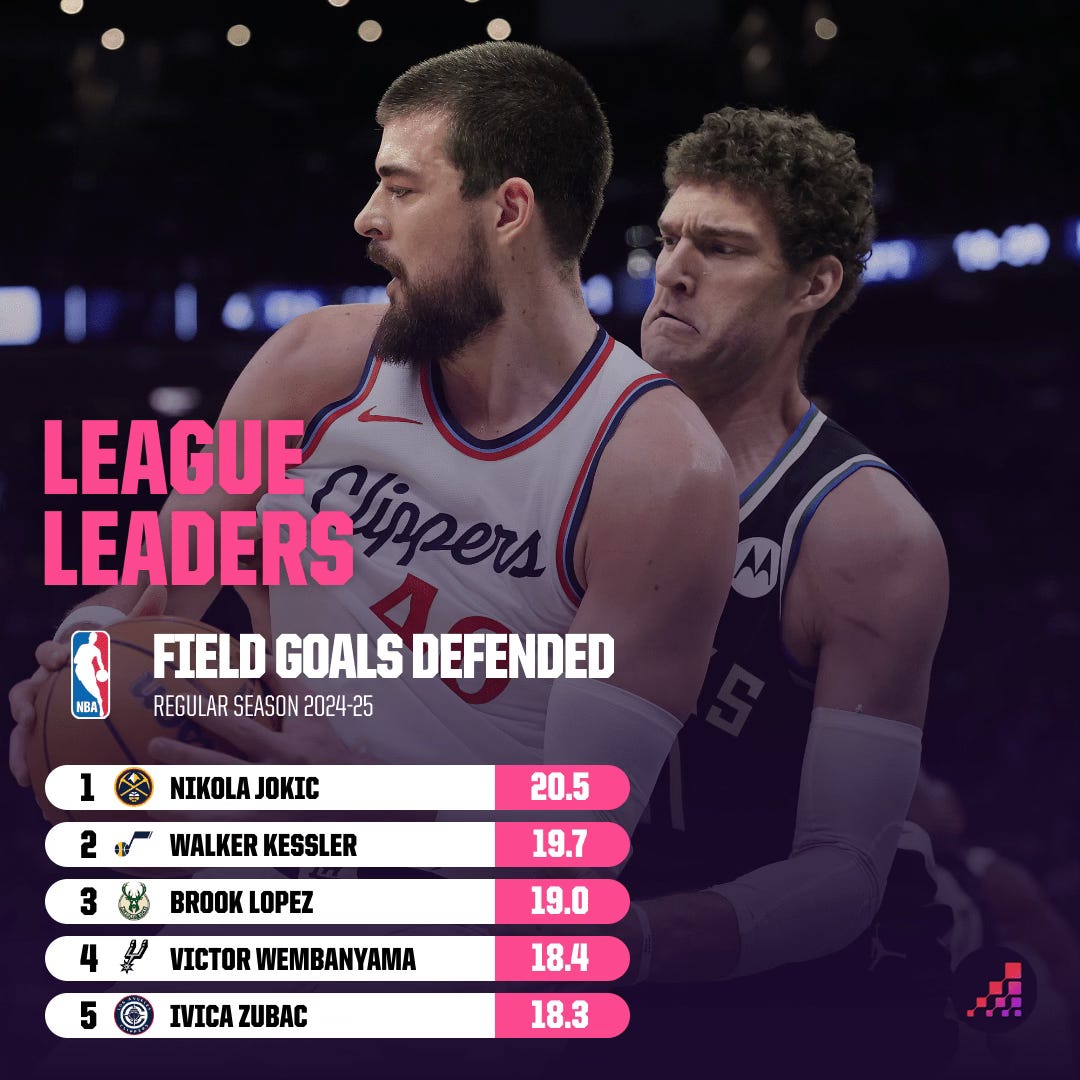
Players shot 2.1% worse on those shots against Lopez, better than Jokic’s -0.4% mark (negative is better for the defender) and somewhat close to Zubac’s -3.2% ranking.
Lopez’s rim protection and overall deterrence comes down to a few factors based on what the film shows: (1) he doesn’t just jump at every feint or look offensive players throw at him, and that discipline matters; (2) Lopez rarely, and I do mean rarely, contests across his body, which means he’s not going to be racking up a ton of fouls; and (3) there’s a real level of basketball intelligence the big man possesses, and you can see it play out a bit in the video above just based on how quickly he reads what’s happening and gets himself back into position to contest shots even if he’s screened, out on the perimeter, or you-name-it. It’s scary.
LOW-MAN AID IS SUPPLIED
All that good stuff includes just doing what he does best: being an elite low-man helper and rim protector.
When his teammates on the perimeter are able to funnel opponents towards Lopez as he waits near the rim, it can get problematic for anyone who dares to challenge him. Yes, he’s going to get caught a few times because, well, that’s the nature of the business. You can’t get blocks unless you’re putting yourself into harm’s way. Remember: willing combatant!
No player in the NBA this past season contested more 2-point shots, per tracking data, than Lopez did. This is part of that. Nothing easy.
NO-FLY ZONE
Speaking of “nothing easy”, we can see it here.
In the film work of Lopez from this past season, one of the more impressive things, besides the fact that the big man gets into an incredible stance on the perimeter, was just how well he contests lob passes. It’s … unreal.
Lopez will spin off of back screens in order to get himself back into plays when there’s a drive happening, but on lobs we see a different type of verve from him. Lopez is able to occupy driving players and then maneuver back to defend lob passes with tremendous aplomb.
Say what you want, but some of these passes are being dunked against other defenders. Lopez is beaten on most of these. His assignment is behind him and it just doesn’t matter. There’s an old adage: if you’re even, you’re leaving. It’s generally a football term to refer to wide receivers matched up against defensive backs. But with Lopez, if you’re even with him on a roll to the rim, you still have to watch out for him rejecting the hell out of you.
LEFT SWAT, RIGHT CORRAL
We mentioned just above the degree to which Lopez can get into a defensive stance, and we see it when we look at this sequence of videos. He gets low on the perimeter against ball-handlers and then basically corrals them as if he’s a cowboy herding wild horses.
It’s a fascinating thing that Lopez does where if it’s a drive down the right side of the floor, the center will put his right forearm and elbow onto the hip of the driver and then contest the shot attempt with his left hand. It’s a subtle way to put pressure on the ball and keep yourself in the play. Plus, it goes into what I said earlier: he doesn’t contest across his body. Everything is contesting away from contact.
For a big man to understand this is pretty gnarly to see play out. Yeah, it’s something most defenders should “get”, but not everyone does. A lot of players will jump across and lean into the driving player in order to block it with their strong hand, but Lopez doesn’t. He’s more than capable of blocking shots with each hand, and as I jotted down in my notes of the plays I looked at on video, 34 of Lopez’s blocks this season came with his left while 83 were with his right.
RIGHT SWAT, LEFT CORRAL
Speaking of those right-hand blocks on drives, here they are. But it’s just the previous situation that’s flipped. Instead of right-side drives, we’re looking at left-side drives that see Lopez put his left forearm and elbow onto the offensive player’s hip, and then he uses his right hand to block the shot.
Once again: good stance, pressure applied, contact initiated, shot defended.
None of these videos, while great to look, get into some of the things I thoroughly enjoyed when looking into Lopez’s defensive film. Two of them are my favorite things about him: (1) he is a persistent 2.9’er, and (2) his blocks get recovered by his team at an unusually high rate.
We’re going to start with the second one first since it’s really fascinating to me.
According to tracking data, the Milwaukee Bucks recovered 68.9% of Lopez’s blocks last season. That means that when Lopez blocked a shot, the Bucks, not the opposition, recovered the ball nearly 70% of the time. If you think that’s a high mark, it is.
Of the players who had 50 blocks recovered by their own team this season, only Luke Kornet (70%) saw a higher percentage of their blocks recovered by themselves or a teammate.
For Lopez’s career, 63.1% of his total blocks have ended up in the hands of his team after he swatted them away. That is a remarkable rate. To put it into context, Dwight Howard’s career mark was 54.8%, and Tim Duncan’s was 61.7%. Anthony Davis? 62.4%. Myles Turner? 58.2%. Rudy Gobert? Jaren Jackson Jr.? 60.4% and 56.2%, respectively.
In fact, his newest teammate, Ivica Zubac, is the only player who can hang around Lopez’s mark, with Zubac himself posting a 63.3% block recovery rate.
In the PBP Stats database, which goes all the way back to the 2000-01 season, there are 115 players that have recorded at least 500 total blocks. Brook Lopez is tied for 7th in block recovery rate during that time amongst those players. The only players ahead of him are Jonas Valanciunas (65.8%), Theo Ratliff (63.9%), the aforementioned Zubac (63.3%), Clint Capela (63.3%), Kristaps Porzingis (63.3%), and Dikembe Mutombo (63.2%).
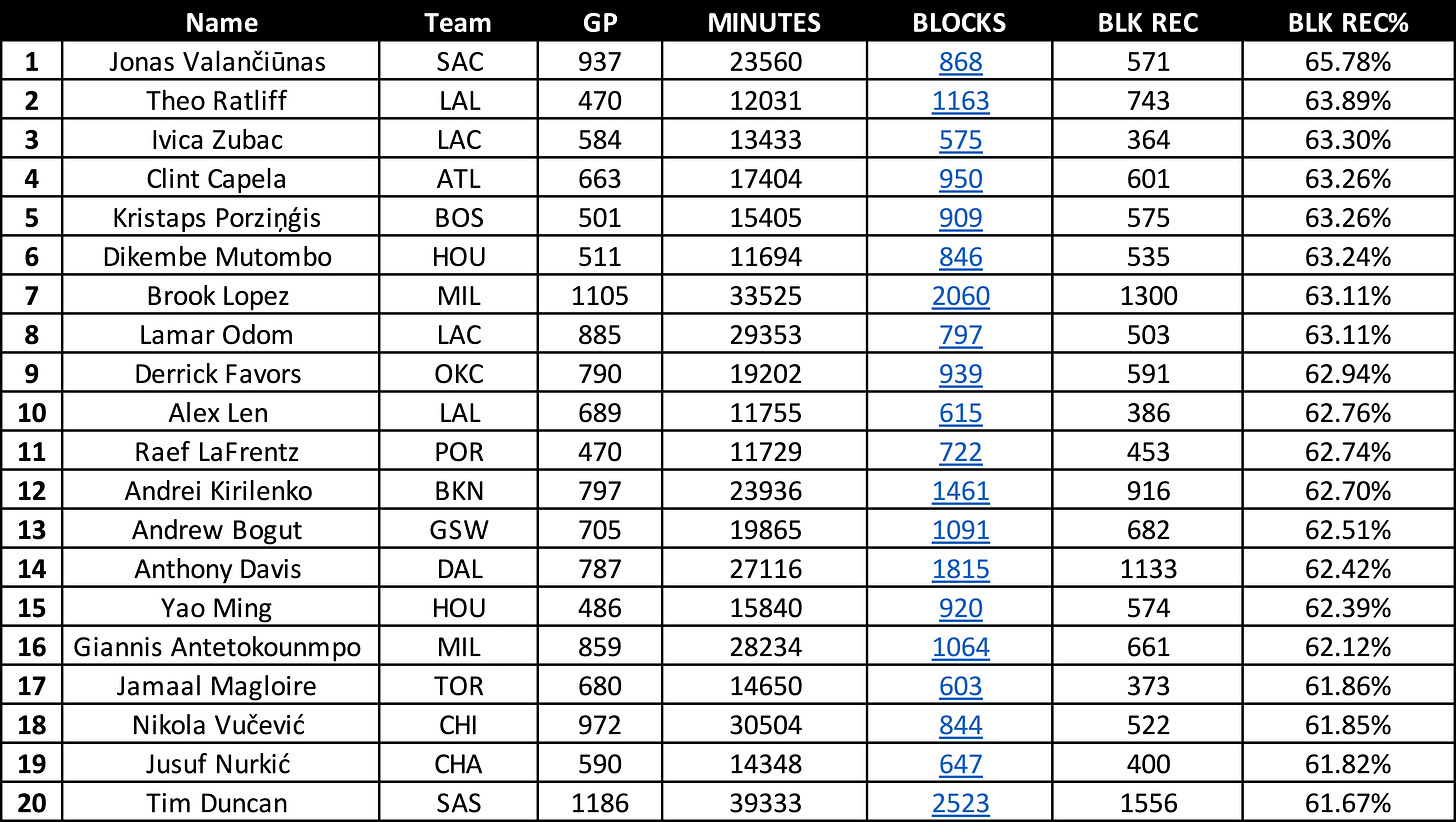
Lopez’s team has recovered at least 60% of his blocked shots in each of the last eight seasons, and that number hasn’t dipped below 59% in any season of his career in which he’s played at least 500 minutes. It might not seem like it, but that’s an incredibly valuable skill.
Now going back to the first point: Lopez has learned a lot playing professional basketball for the last 17 seasons. One of them is the value in being an adept 2.9’er. Some of you probably already know what that means, but for those who don’t, Lopez plays a game of chicken, so to speak, with officials and opponents by attempting to stay in the paint longer than a lot of players typically can or even attempt.
Lopez generally maintains contact with his assignment or a player near him in the painted area so as to reset the count and keep himself tethered to the basket a little longer than usual.
While it has led to some whistles, 148 ‘Defensive 3 Seconds’ calls in just over 33,000 career minutes, or roughly about 0.13 per 30 minutes played, it’s perhaps not as bad as first anticipated. Lopez is roughly right in the middle of what Yao Ming (0.14) and Ivica Zubac (0.12) have been able to do.
(Tim Duncan was a freak at this, by the way. In the PBP Stats database, Duncan played 39,333 minutes since the 2000-01 season and only racked up 74 ‘Defensive 3 Seconds’ violations, or 0.06 per 30 minutes. It means that over a 2,000-minute season, Duncan would get called for, on average, just 3.76 per year. For context: Andre Drummond had 5 of them last season in just 751 minutes.)
Lopez is going to get called for violations attempting this. I’m just letting everyone know that now. But the fact he’s willing to keep trying to find even the tiniest bits of advantage on the floor is a positive, and it’s one of the reasons, even if incredibly obscure, why you should be excited for the vet center on the defensive end.
He’s not afraid to try things!
❹ MAXIMIZING THE GIVEN OPTIONS
When talking about the lineup variations and the flexibility afforded to the Clippers, I don’t think it’s out of the realm of reality to discuss Lopez’s place within that pecking order.
This is a dude who has logged considerable time alongside a variety of players and skill sets, and he’s been a high-level, functioning two-way big despite all of that. Even beyond the finicky fit with Zubac, I think there’s some intriguing lineup possibilities with Lopez.
Whether it’s James Harden or—*gulp*, Chris Paul?—a bench guard, I think there’s a mix of players who can thrive around Lopez’s veteran knowhow and skills.
All told, I think you’re going to see something like this:
1) Brook Lopez
2) James Harden -OR- Kris Dunn -OR- [insert guard]
3) Kawhi Leonard -OR- Derrick Jones Jr.
4) John Collins -OR- Nicolas Batum
5) Wild Card
That last spot is something the Clippers can get creative with. But, at the very least, I think you can expect a host of different lineups with Lopez in them.
You could see something such as Harden, Beal, Leonard, Collins, and Lopez, a nod to five-out spacing while still having rim protection. Maybe even something like Kris Dunn, Bogdan Bogdanovic, Derrick Jones Jr., Nicolas Batum, and Lopez, a full bench unit that still has three highly-graded defenders, a pick-and-roll guard (Bogdanovic), and some necessary spacing. Hell, don’t even rule out a combination of Harden, Dunn, Leonard, Batum, and Lopez. Or Beal, Dunn, Jones, Collins, and Lopez. There’s a lot!
Out of all the players that the Clippers have added this offseason, I find Lopez the most fascinating from a lineup perspective, if only because in theory you’d think he has to be pigeonholed into a specific slot and need certain players around him. However, I don’t think that’s the case. I think his track record of success, the plethora of talented players he’s logged considerable minutes alongside, and the versatility he provides allow him to succeed next to a whole host of lineup machinations.
You want a rather insane Brook Lopez lineup stat from last season?
You know how it was touched on way earlier that the trio of Lillard, Antetokounmpo, and Lopez had a +5.2 Net Rating together this past year? If I asked you how many minutes that trio logged alongside Bobby Portis, what would you guess it was? 500? 250? 100? The answer is: ZERO. Not one damn minute. That’s a quartet that logged 80 games (Lopez), 67 (Antetokounmpo), 58 (Lillard), and 49 (Portis). Those four players played in the same exact game 32 times last season. But not a single minute spent together.
The reason I bring this up is because during the 2023-24 season, those four played in the same game 63 times. And still only logged 22 total minutes together.
That means that in two years, what you could possibly argue were Milwaukee’s four most important players played a grand total of 22 minutes as a quartet out of 95 possible games where all four individually saw the floor at some point.
Believe me, I understand the thought you might have: But why would they play those three bigs—Antetokounmpo, Portis, and Lopez—all together? But I’d retort back with, why wouldn’t you just try it? And certainly for more than 22 freaking minutes over two years. Experimentation isn’t supposed to be feared; it’s meant to be embraced and tinkered with. I think you can expect Tyronn Lue to try things such as this just to see what may or may not be viable.
(The Lillard, Antetokounmpo, Lopez, and Khris Middleton lineups logged 1,448 non-garbage time possessions in 2023-24, by the way, and posted a ridiculous +16.3 Net Rating in the process. Only 221 such possessions this past season before Middleton was traded, and they went -0.4. On the flip side: Kyle Kuzma added into that trio in place of Middleton was a +9.0 in 486 possessions. Just giving you an idea of what it can look like with archetypal variations of Bradley Beal and John Collins, respectively.)
Now, aren’t you excited about a possible Harden, Beal, Leonard, Collins, and Lopez lineup? This is why Brook Lopez is so damn fascinating!
❺ LOOKING BACK TO PROJECT FORWARD
We’ve touched on his Milwaukee stint quite a bit throughout this Splash Mountain manifesto—god, what an all-time great athlete nickname—but I do think there’s a bit more we can glean from it and then apply it to this upcoming stint with the Clippers.
Over seven years in Milwaukee, Lopez spent 8,204 of his 13,669 minutes tied to Giannis Antetokounmpo. When 60% of your minutes come alongside one guy, especially over that duration of time, it tells you just how things looked over there.
Even though the Bucks posted a -3.2 Net Rating in 2,109 possessions that Lopez played without Antetokounmpo this season, it’s hard to pin it all on the big man. It was actually just a -1.3 Net Rating in a scant 830 possessions without both Antetokounmpo and Damian Lillard. Just two years prior, during the 2022-23 season, the Bucks had a +4.3 Net Rating in 2,619 possessions that Lopez spent without Antetokounmpo out there, which you could argue were buoyed a bit by Jrue Holiday (+6.1 Net in 1,594 possessions). But even then, the Bucks had a +1.4 Net Rating in 2022-23 when Lopez played without both Antetokounmpo and Holiday.
Does that mean anything? No, of course not. Not for 2025-26, at least. But it gives you a brief glimpse into what was, and why Lopez rates so highly as an overall fit.
Up above in the section about how Lopez and Zubac could potentially fit alongside one another, I mentioned that Serge Ibaka played 66 minutes with Zubac during their time in Los Angeles. What I didn’t mention was that 65 of those 66 minutes came during the 2021-22 season, when Ibaka was recovering from back issues and seemingly on his way out of the league as a result of the injuries taking their toll on him.
There was another part that I left out: the lineups that Ibaka and Zubac played against, especially in those two games alongside George, Jackson, and Morris.
The lineup they performed the best against was a Lakers one that featured Russell Westbrook, Talen Horton-Tucker, LeBron James, Anthony Davis, and Dwight Howard. They outscored the Lakers 24-17 in 10:51 against one another. They then outscored another Lakers lineup—Malik Monk, Horton-Tucker, James, Davis, and Howard—by 5 points in 3:05. They outscored a third Lakers lineup—Westbrook, Monk, Horton-Tucker, Davis, and Howard—by 2 points in 0:58. However, they were outscored by 6 points in 2:19 by a Lakers lineup that had Wayne Ellington, Carmelo Anthony, Westbrook, James, and Davis.
If you’re keeping track at home, and this is real sicko stuff to pay attention to, the Clippers outscored the Lakers with Ibaka and Zubac on the floor by 14 points in 15:01 when the duo was up against a double-big lineup of Davis and Howard. Yeah, that’s right. The Clippers, and specifically head coach Tyronn Lue, matched up like-for-like with the Lakers’ double-big look and thumped them with it. In the 3:24 that Ibaka and Zubac played against a one-big look (and it was Davis in the two lineups they went up against), the Lakers outscored the Clippers by 5 points.
It’s hard to fathom just how much Lopez can help the Clippers at a position they have lacked serviceable representation in over the last several years. Since losing Isaiah Hartenstein, it’s been a revolving door of hopeful swings and many misses.
Lopez can change that, and he can change it pretty emphatically just based on his track record and skill set. That’s what should get people excited. They’ve never had this type of big man before, even when adjusting for Serge Ibaka years ago.
Maybe the fit of Lopez won’t work out the way that the Clippers, Lopez, and the fanbase hope it will. That is a possibility, after all, due to both Lopez’s age (37) and, well, just the natural progression of things. Nothing lasts forever.
But if it does work out, things are looking up for the Clippers in a major, major way. Lopez provides them with everything they need out of the backup center position, even at his advanced basketball age.
To tie things back into Dusty Rhodes and his iconic promos, maybe Brook Lopez, while not how the athlete of the day is supposed to look, could be the Cold-Blooded Sausage Maker that the Clippers have looked for, a powerhouse of impact who can propel them into the upper echelon of contenders. Perhaps it was risky business to go get him, but without risk, you can’t reap reward.
Because that’s risky business. I am risky business. I am the cold-blooded sausage maker.
(If you made it all the way to the end, I appreciate it and can’t thank you enough. And, if you ever get the time and haven’t ever looked them up before, go check out the Dusty Rhodes promos. Even if you don’t like wrestling at all. We respect legends around here.)









The amount of work put onto these are insane! I'm excited for the Clippers next season for sure. Thanks JR
Best write up of the year!